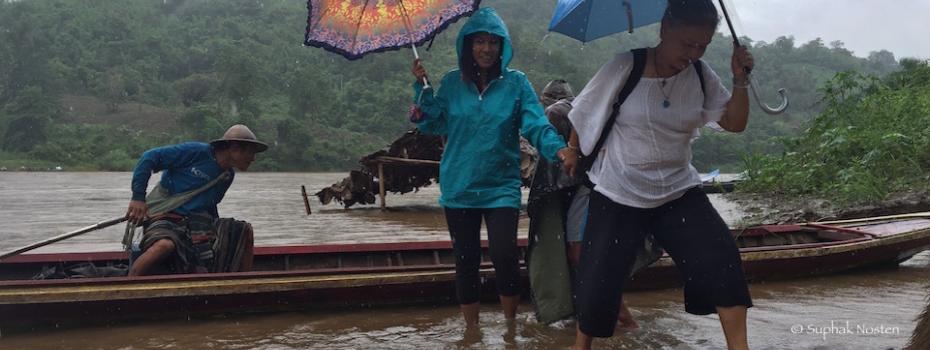Community Engagement
Community engagement (CE) is a process by which a dedicated CE team (usually consisting of 5 – 15 people from the programme team and the community) works to build relation and trust to facilitate community ownership and understanding of the malaria elimination project. The entire programme relies on widespread participation and cooperation within and between villages in the area. The success (or potential failure) of the project is therefore heavily dependent on the ability to properly interact with the population, making CE a cornerstone of the malaria elimination programme. What we have learnt on CE as part of the malaria elimination programme will be very useful for other SMRU activities such as the tuberculosis control and the maternal health programmes.
The malaria-focused CE work started with four pilot villages as part of the TCE study in 2013. Through the experiences gained and lessons learned a guiding set of key themes was established including principles and methods that could be applied across a wide geographic range in the scale-up programme (i.e. METF). Three major themes emerged from this preliminary work: human behaviour, geography and social structures.
Human behaviour: CE workers and other malaria elimination team members must work toward understanding community members worldviews, the ways that they allocate their time and the motivations and desires that drive their decisions and decision- making processes. For example, CE and other malaria programme tasks must not conflict with the workload of the people. Most rural villages in the METF area follow a basic calendar revolving around rice paddy farming and several other crops (Figure 4). Harvest seasons (September to December) are typically labour-intensive and require some farmers to spend up to several weeks away to protect the crops and harvest them.
Geography: The physical and social geographic attributes of a community have important correlates with regard to CE, public health and ultimately malaria elimination. The relative physical and/or social isolation can have a major impact on the knowledge and understanding of community members as well as on health-related work. People in remote locations are often poor and have little understanding of malaria or other public health threats.
Social structures: It is crucial that CE team members understand and utilise some of the existing social, political and economic power structures in place. Such systems include local village heads, township health officers, important religious and other political and military actors. Socio-political dynamics can dictate appropriate means of engaging with community members and rolling out health-focused projects. Karen state has many different political actors, some operating simultaneously in the same areas. This political complexity can make implementation of health programmes very challenging. The malaria elimination project has been able to work in communities despite these potential obstacles through the incorporation and help of important key contacts. It is often possible to directly go to upper level health officials and obtain permission to set up a malaria programme in an area. Without community acceptance, however, implementation at the ground level may flounder.
CE training for MPs: Malaria posts are typically established in batches. Prior to MPW training, the CE team asks for a meeting with local health workers, village headmen, and other leaders. During this initial meeting the programme, MP function and CE are explained to local leaders. CE training also takes place with the MPW during training workshops. MPWs are taught about malaria biology and ecology, how to prevent malaria and what to do in case of malaria symptoms. This training is valuable for the MPWs who will also convey this knowledge to community members. The MPW effectively becomes an important extension of the CE team, as he/she is already part of the local community.
Malaria prevalence surveys: Before embarking on a survey, the project team meets to discuss the detailed planning. Township-level health care leaders and village headmen are then invited to attend a meeting at a central location so that the plan can be proposed and the CE team asks for permission to conduct the surveys. Survey planning relies heavily on village headmen, who notify and gather the participants on the specific day and time(s). The concept of submicroscopic malaria is quite complex and difficult to explain. Several workshops are organised to train local leaders (health care workers and village headmen) who are already trusted by local villagers and can therefore aid in the dispersal of knowledge and information.
MDA preparation: Once a village is identified for MDA, plans begin for CE exercises aimed at community preparedness. The Area and Zone coordinators inform the village headmen. The CE team arrives 2 days prior to the beginning of MDA in order to organise and set up new meetings with leaders and villagers to explain the medication, the potential side effects and the regimen that will be followed. The MDA team stays in a village for 7 days per visit to document any side effects, to address any concerns and to treat other minor illnesses. In villages with MPs already in place feedback from villagers after the 7-day period will come via MPW through MP supervisors, Zone coordinators and Area coordinators.
CE as an iterative process:
CE is not a short-lived process with successes or failures that can easily be measured. The trust and understanding are based on dynamic relations with the community. Part of this relationship includes providing feedback about the project and reacting to new developments including rumours that can be detrimental.
Tools and activities used for CE:
- Workshops, trainings, and group discussions (focus groups).
- Demonstrations and hands-on activities-learning materials including handouts, manuals and posters.
- Capacity building activities aimed at youth, including children’s songs and poems, drawing, school activities aimed at teaching scientific methods.
- Participation in monthly village meetings, celebrations, and community work activities (such as farming).
- Household visits.
- Village incentives (water supplies or systems, buildings for community activities, solar panels, some training opportunities for health workers, boosting existing medical capabilities, providing basic out-patient care while the team is in the field).


